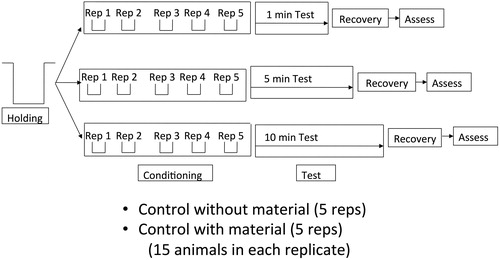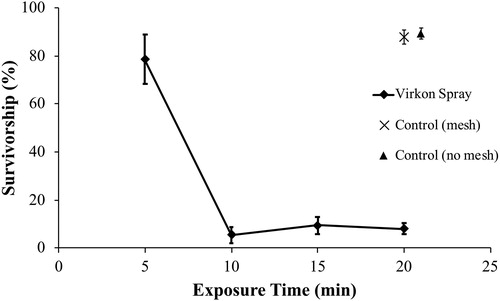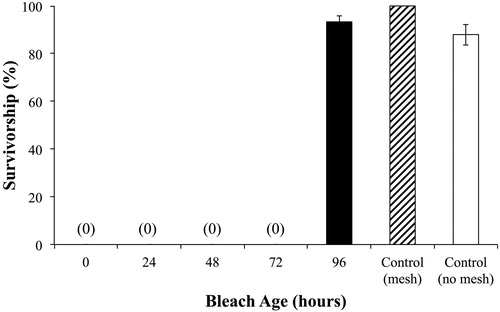Figures & data
Table 1. Collection sites for aquatic invasive species tested in disinfection experiments.
Figure 1. Example of experimental design for disinfection tests of aquatic invasive species, including three exposure durations. Holding period refers to the time between collecting animals from the field and the start of experiments. Two control treatments were employed for each experiment to assess possible influence of materials on survivorship.

Table 2. Summary table of combinations of materials tested, decontamination treatments (Virkon, bleach, freezing, hot water, and drying), and application method (I = immersion, S = spray) for species used in the experiments.
Figure 2. Survivorship (mean ± 1 SE percent) of faucet snail (Bithynia tentaculata) following spray exposure on nylon mesh for various time periods to Virkon Aquatic (2%). For clarity purposes, the symbol for Control (mesh) results at 20 min is offset by 1 min on the graph.

Table 3. Mean survivorship (percent) for animals exposed to Virkon Aquatic (2%) at longest time period tested. Results shown for immersion tests (I) and spray (S) applications. Standard error of mean shown in parentheses. Asterisk indicates that 95% confidence interval does not include 0% survivorship. Dash indicates treatment combinations that were not tested.
Table 4. Mean survivorship (percent) for animals exposed to bleach for 20 min. Results shown for immersion (I) and spray (S) applications. Standard error of mean shown in parentheses. Bleach concentration was 400 ppm, except for bloody-red mysid tests, which employed 500 ppm. Asterisk indicates that 95% confidence interval does not include 0% survivorship. Dash indicates treatment combinations that were not tested.
Figure 3. Survivorship of bloody-red mysid (mean ± 1 SE percent) exposed for 20 min to bleach (500 ppm) that was aged increasing amounts of time. Animals were attached to nylon mesh and sprayed with bleach.

Table 5. Mean survivorship (percent) for New Zealand mud snail exposed to Formula 409 for 20 min. Results shown for immersion and spray applications, and without mud or with mud present. Standard error of mean shown in parentheses. Asterisk indicates that 95% confidence interval does not include 0% survivorship.
Table 6. Results summary of experimental combinations of materials tested and decontamination treatments (Virkon, bleach, freezing, hot water, and drying) for species used in the experiments. Treatments were considered either effective (E) or not effective (NE) for practical decontamination of sampling gear.
